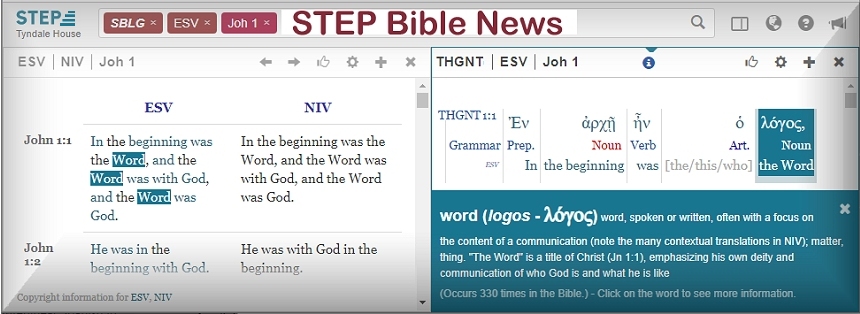Majority Languages
Biblica owns and curates the NIV to ensure it keeps up with research and language changes. They aim to translate the Bible as accurately and idiomatically as a United Nations translator. For example, the NIV recently changed the word 'booty' to 'plunder', and 'aliens' to ‘landless immigrants’.
Biblica also supports
about a hundred translation committees in other languages. These committees work on Bibles in 'majority' languages - i.e., the languages
understood by the majority of people in the world. Those who speak minority
languages are usually bilingual - they have to be - because they also need to
know a majority language. So these majority languages are closer to being their
‘own’ language than a second language normally is.
These translations now available in STEPBible, like the NIV, are written in a contemporary version of the language, without confusing out-of-date terminology. Often a strict word-to-word translation is useful when studying the underlying Hebrew or Greek. At other times it is useful to read a contemporary language translation that is straightforward to help to understand a Bible passage. STEPBible can show both types of Bibles side by side, with links to the original vocabulary they are translating, and tools to investigate them deeply.
The best of all Bible reading experiences is therefore now freely available in STEPBible. Everyone can read an easy-to-understand Bible in a majority language accessible to them, alongside translations that reflect word order and language traits of the underlying Hebrew and Greek. This mixture is the best way to read the Bible you love, and you can study words in depth when you come across something intriguing.
We would love to learn about how you are use STEPBible. Your feedback will help us to develop and enhance its capabilities. Please email STEPBibleATgmail with a note on how you use STEPBible. What ideas do you have to make STEPBible better? Do you know missionaries, church communities or others who would benefit from STEPBible? If you haven't already, please tell them about this resource. Would you like to help mature STEPBible? Let us know what you're good at. We particularly need help with translations of the interface into other languages.
Every
blessing
David
Instone-Brewer and the rest of the STEPBible team.
Try out the new Bibles at: www.STEPBible.org
New Amharic Standard Bible 2001
New Arabic Version 2012
Cebuano Contemporary
Bible 2014
Czech Living Bible 2012
Kurdish Sorani Standard Version 2020
Chinese Contemporary Bible (Simplified
Script) 2011
Chinese Contemporary Bible (Traditional
Script) 2012
The Bible in Everyday Danish 2015
Ewé Contemporary Version 2006
Gbagyi New Testament 1997
Hausa Contemporary New
Testament 2009
“The Way” Hebrew Living NT 2020
Hiligaynon Bible 2011
Hindi Contemporary Version 2019
The Book of Christ, in
Croatian 2000
Igbo Contemporary Bible, New
Testament 2019
Indonesian: Firman Allah Yang Hidup 2020
The Holy Word of God, in
Gikuyu, Kikuyu 2013
Korean Living Bible 1985
Luganda Contemporary
Bible 2019
Malayalam Contemporary
Version 2017
Ndebele Standard Bible 2006
New International Readers
Version 2014
New International Version 2011
New International Version, UK
spelling 2011
Het Boek, in Dutch, Flemish 2007
The Word of God, in Contemporary
Chichewa 2016
Persian Contemporary Bible, in
Farsi 2020
Polish Living New Testament 2016
Nova Versão Internacional, in
Brazilian Portuguese 2011
New Romanian Translation 2016
Central Asian Russian
Scriptures 2013
Central Asian Russian Scriptures (with
'Allah') 2013
Central Asian Russian Scriptures, in
Tajik 2013
New Russian Translation 2014
Slovenian Living New
Testament 2014
Shona Contemporary Bible 2018
Nueva Versión Internacional, in
Castilian Spanish 2017
Kiswahili Contemporary Version 2015
Tagalog Contemporary
Bible 2015
Thai New Contemporary Version 2007
The Word: Living Tswana New
Testament 1993
Akuapem Twi Contemporary Bible 2020 2020
Vietnamese Contemporary
Bible 2015
Kiyombe Contemporary Version 2002
Yoruba Contemporary Bible 2019















